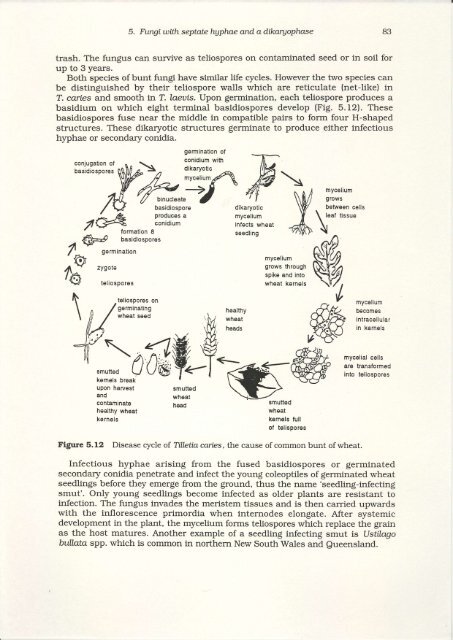Fungi with septate hyphae and a dikaryophase
Fungi with septate hyphae and a dikaryophase
Fungi with septate hyphae and a dikaryophase
You also want an ePaper? Increase the reach of your titles
YUMPU automatically turns print PDFs into web optimized ePapers that Google loves.
5. <strong>Fungi</strong> usith <strong>septate</strong> hgptne attd a dikargophase B3<br />
trash. The fungus can survive as teliospores on contaminated seed or in soil for<br />
up to 3 years.<br />
Botl. species of bunt fungi have similar life cycles. However the two species can<br />
be distinguished by their teliospore walls which are reticulate (net-like) in<br />
T. caries <strong>and</strong> smooth in T. Laeuis. Upon germination, each teliospore produces a<br />
basidium on which eight terminal basidiospores develop (Fig. 5.12). These<br />
basidiospores fuse near the middle in compatible pairs to form four H-shaped<br />
structures. These dikaryotic structures germinate to produce either infectious<br />
<strong>hyphae</strong> or secondary conidia.<br />
*"'*"*M4^'"<br />
coniusationor<br />
^-,\ :il1'$$- W<br />
f rF\ r*r"r'"<br />
/ \f basidiospore dikaryotic V/ . between cells<br />
4G4'**,fl?Lffi" fr;::J^"" ^V1'*"<br />
:f;'n.::''i:'o'oo'"'<br />
T6 ';:;.0",".<br />
;n"1.iil",: M<br />
n:::li*i<br />
wrfgdt trglltt 15 \U\,<br />
/<br />
I<br />
tlt<br />
tefiospores on<br />
mycerium<br />
germinating<br />
heatthv tqfu 8.H, becomas becomes<br />
wheat seed ,.h"r li*t ,€Ih intracerurar<br />
'Xf{ heads<br />
in kerners<br />
ffiK5<br />
.--tV: M. l/\d"<br />
furuWk@il:H:,;<br />
upon harvest<br />
<strong>and</strong><br />
contaminat€<br />
heatthy wheat<br />
kernels<br />
smutted<br />
wh€at<br />
head<br />
smutted<br />
wheat<br />
kernels full<br />
of telispores<br />
Figtrre 5.12 Disease rycle of TitLe{La caries. the cause of common bunt of wheat.<br />
Infectious <strong>hyphae</strong> arising from the fused basidiospores or germinated<br />
secondar1r conidia penetrate <strong>and</strong> infect the young coleoptiles of germinated wheat<br />
seedlings before they emerge from the ground, thus the name'seedling-infecting<br />
smut'. Only young seedlings become infected as older plants are resistant to<br />
infection. The fungus invades the meristem tissues <strong>and</strong> is then carried upwards<br />
<strong>with</strong> the inflorescence primordia when internodes elongate. After systemic<br />
development in the plant, the mycelium forms teliospores which replace tJle grain<br />
as the host matures. Another example of a seedling infecting smut is lJsttlago<br />
btillata spp. which is common in northern New South Wales <strong>and</strong> Queensl<strong>and</strong>.






![[Compatibility Mode].pdf](https://img.yumpu.com/27318716/1/190x135/compatibility-modepdf.jpg?quality=85)










